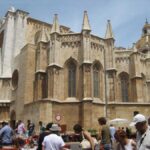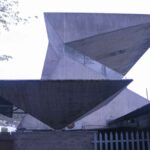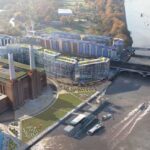Contemporary Colombia Architecture, Colombian Building, Project, News, Design, Image
Contemporary Colombian Architecture
New South American Architectural Information
10 Aug 2010
The Renaissance of Contemporary Colombian Architecture
Article by Dr Karim Hadjri, Senior Lecturer in Architecture
School of Planning, Architecture & Civil Engineering, Queen’s University Belfast
Contemporary Colombia Buildings
e-Architect’s kind invitation to be a guest editor for this issue has encouraged me to write a contribution on Contemporary Colombian Architecture in order to acknowledge and publicise the current remarkable work of leading Colombian architects but also that of emerging ones.
My professional experience in Colombia in the late 1990’s brought me closer to the wealth and sophistication of Colombian architecture, which I was not aware of simply because it was not well publicised internationally. I was then able to – and still do – appreciate the work produced over the last 50 years by influential architects such as Rogelio Salmona, Guillermo Bermudez, Enrique Triana Uribe, and German Samper.
Likewise, during the last decade following regular visits to the country, I have been able to experience the inspirational work of colleagues and friends architects who have continued to make a lasting impact on contemporary architecture in Bogotá in particular and Colombia in general, namely Daniel Bermudez (Centro Cultural Biblioteca Pública Julio Mario Santo Domingo, Bogotá ), Daniel Bonilla (Chapel of Porciúncula de la Milagrosa, La Calera, 2nd winner of the ar+d award for emerging architecture in 2004; Edificio Administrativo Colegio Los Nogales, which was awarded a Honourable Mention at XXIst BCA Colombian Biennale of Architecture 2008), and Juan Carlos Rojas Iragorri with Enrique Triana Uribe (Sala de Exposiciones Temporales, Bogotá – Winner of XXth BCA 2006). This is in addition to the growing collection of innovative and expressive architecture from architects such as Giancarlo Mazzanti.
The recent establishment and increase in national design competitions for public buildings in Colombia have in a way benefited the less known and less experienced architects, given that many large scale projects have been unexpectedly won by very young architects whose work has started to attract worldwide attention.
One has to understand the complex and troubled history of Colombia in order to appreciate the challenges faced by those concerned with the built environment such as architects, but also those dealing with social, political, and environmental issues, hence their achievements should not go unnoticed. Luckily, the last decade has seen a noticeable increase in public spending and efficient city planning strategies that have dramatically improved the transport infrastructure, and developed social and community facilities in Bogotá and more recently in Medellin and other Colombian cities. This has also been encouraged by the much improved security situation.
More recently and not surprisingly, there has been an emergence of very promising young architects who have managed to design and erect an impressive portfolio of high quality architecture sometimes in the most challenging of sites. A glimpse of what contemporary Colombian architects are producing can be seen at the Colombian Society of Architects (Sociedad Colombiana de Arquitectos) through its XXIInd Biennale of Architecture 2010.
The Biennale’s jury reported that this year’s submissions reflect the diversity and vitality that is rife within contemporary Colombian architecture, and the interest of designers not only to respond to complex social, political and cultural needs, but also to explore new built forms and to use conventional materials in an innovative way. The winning project of this year’s prestigious Colombian award for Architecture was the Escuela Santo Domingo Derka, Medellin, designed by Obra Negra Arquitectos, a team formed by three young architects namely Carlos Pardo Botero, Nicolás Vélez and Mauricio Zuluaga. One of the five projects with a Honourable Mention was Giancarlo Mazzanti’s Jardin Infantil El Porvenir.
Some of the most impressive new projects in Medellin were designed by young emerging architects such as Edgar Mazo, Sebastian Mejia and Luis Callejas of Paisajes Emergentes who designed the aquatic complex. Felipe Uribe de Bedout designed the Biblioteca de Empresas Publicas (Honourable Mention at XXth BCA 2006), and Colegio La Indepencia in Medellin.
Plan B Architects founder Felipe Mesa with Alejandro Bernal, Jean Paul Restrepo and Camilo Restrepo, have also made a noticeable impact in Medellin by designing for instance the Orquideorama – The Orchid House, at Medellin Botanical Garden, a display of environmental consciousness and sustainable design, which received a Honourable Mention at XXIst BCA 2008. Felipe Mesa and Giancarlo Mazzanti also designed, for the South American Games in 2010 in Medellin, four sport halls using a striking green undulating steel roof.
A remarkable achievement that is worth mentioning is the Park and Library scheme in Medellin, launched in 2004 by the then mayor of Medellin Sergio Fajardo, which has contributed to the renaissance of contemporary architecture in this city following decades of violence and neglect particularly in popular neighbourhoods. I was fortunate to visit some of these iconic projects when they were under construction in late 2006.
Giancarlo Mazzanti has won two competitions under this scheme, Biblioteca España – Santo Domingo Savio, and Biblioteca Ladera – León de Greiff. The other three libraries have been designed by Javier Vera (Honourable Mention at XXIst BCA 2008), Ricardo La Rotta, and the Japanese Hiroshi Naito. Besides, two new libraries and parks are currently under construction. The international competitions for 12th October and San Cristobal libraries and parks were won respectively by a team led by Diego López Chalarca, and Orlando García.
Antonio Sofan is another emerging architect based in Bogotá with professional experience in the USA whose work explores colour and sustainable design. He has two interesting housing projects posted on e-Architect, namely Sinu River House and Santa Elena House.
Also worth highlighting is the role that female Colombian architects are playing in this accomplishment. Firstly, Ximena Samper de Neu and Brianda Mercedes Reniz Caballero are respectively the current president and vice-president of the Colombian Society of Architects – Cundinamarca Chapter, and Ana María Valenzuela Gómez is the national vice-president, which is very significant. In addition, a number of female architects have won awards such as the project Café del Bosque at Medellin’s botanic garden designed by Lorenzo Castro and Ana Elvira Vélez, which received a Honourable Mention at XXIInd BCA 2010. Ana Elvira Vélez, with Juan Bernardo Echeverri, have also designed the Punta Piedra project, an imaginative scheme comprising 412 housing units on a very steep slope in Medellin, which received a Honourable Mention award at XXth BCA 2006.
Patricia Gómez, Jorge Mario Gómez and Fabio Antonio Ramírez were the winners in the Heritage Conservation category at the XXIInd BCA 2010, with their reconversion project for Medellin’s museum of modern art. Another successful practice in Medellin is Ctrl G Architecture studio run by two young female architects, Catalina Patiño and Viviana Peña. This practice has won the international competition for the extension to the Museum of Modern Art in Medellin – MAMM in collaboration with Peru-based studio 51-1 Architects.
There is no doubt that these new buildings are generating a healthy debate amongst architects and the general public on what is truly contemporary Colombian architecture, and to what extent are Colombian architects being influenced by the international style. I am sure that opinions are divided, that controversy can be beneficial, and that Colombian architects’ exposure to the international architecture discourse can only strengthen their resolve to produce architecture that creates a genius loci, is inclusive, and displays individuality, but also that is cutting-edge.
Architectural education in Colombia is one of the best I have come across. Colombia has a large number of schools of architecture – 56 of which 43 are private – accredited by the Ministry of Education. Part 1 and 2 courses at five schools of architecture are validated by the RIBA, which is an acknowledgement of the quality of some of these programmes.
I am sure that there are many more outstanding architects and buildings that I have not mentioned in this short article. What is certain is that there has always been a notable creative design and craftsmanship talent in Colombia, which continues to be evidenced through high quality and award-winning architecture and spectacular handicrafts.
Finally, I strongly encourage Colombian architects to publicise their work more assertively by submitting their schemes to international publishing organisations and online resources such as www.e-architect.com, because the few projects found online do not fully illustrate the breadth, depth and wealth of contemporary Colombian architecture.
Contemporary Colombian Architecture Designs
Santa Elena House
Architects: Antonio Sofan
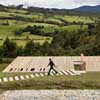
photo : Carlos Tobon
Santa Elena House
Biblioteca Pública Santo Domingo Colombia
Architect : Mazzanti Arquitectos, Bogotá, Colombia
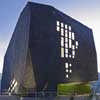
photo : Sergio Gómez
Biblioteca Pública Santo Domingo Colombia
Sinu River House
Antonio Sofan architect
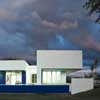
photo : Carlos Tobon
Sinu River House
Location: Colombia
Colombia Architecture
Contemporary ColombiaArchitectural Projects
Colombia Architecture Design – chronological list
Colombian Architect Studios – Design Office Listings
South American Architecture
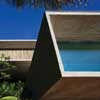
image : Pedro Vannucchi
Dr Karim Hadjri
Senior Lecturer in Architecture
School of Planning, Architecture & Civil Engineering
Queen’s University Belfast
Belfast, Northern Ireland, UK
email [email protected]
web http://www.qub.ac.uk/arc
Bio:
Karim Hadjri is an architect from Algeria where he was awarded a Diploma in Architecture in 1985, and a scholarship to pursue postgraduate studies in the UK. He completed a Master of Philosophy in 1989 and a Doctor of Philosophy in 1992 at the Joint Centre for Urban Design at Oxford Brookes University, on housing studies.
He has worked as a scholar in the United Kingdom, Cyprus, UAE and Saudi Arabia. He was head of the department of architecture at the European University of Lefke in Cyprus during 1995-1996, and the director of the Centro de Planificación y Urbanismo (CPU and later CIFAD) at Universidad de Los Andes during 1997-1998.
His research interests are concerned with architectural computing, Space Syntax, and inclusive housing design and wellbeing with particular emphasis on older users.
Karim has also practiced architecture in parallel with academia and designed a school of architecture, a university library and private housing.
He has a Colombian wife and a 15 year old son.
Developments in countries nearby
Comments / photos for the Contemporary Colombia Architecture page welcome


